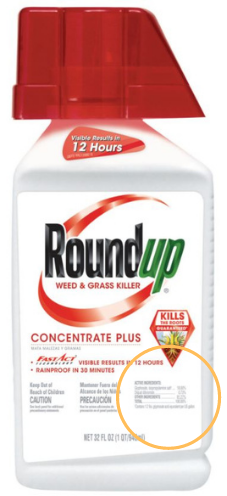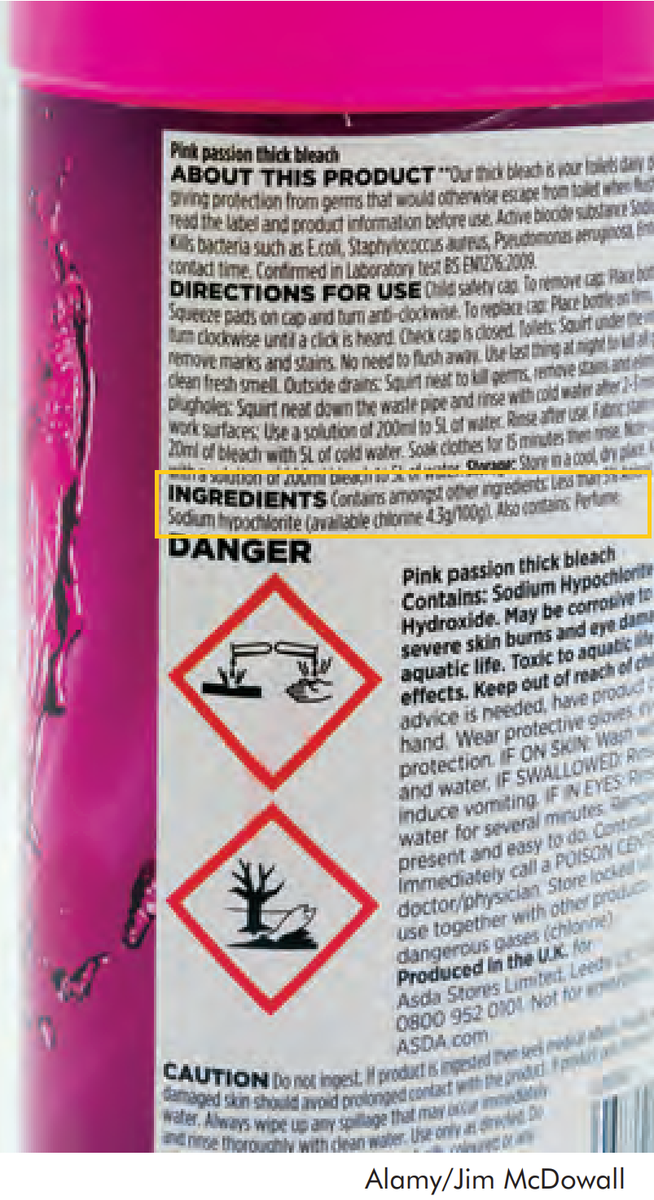Gateway on Pesticide Hazards and Safe Pest Management
How To Find Ingredients in Pesticide Products
Beyond Pesticides offers resources below to evaluate the health and ecological effects of specific chemical exposure from ACTIVE INGREDIENTS in pesticide products, as well as regulatory information and supporting scientific documents. Because various pesticide products can contain more than one active ingredient, it is important to READ the LABEL to determine chemical components.
With 192 different active ingredients and counting, it is essential to establish the connection between the use of these chemicals and their respective hazards.
View the step-by-step guide on how to search for the active ingredient(s) in pesticide products below:
- Go to U.S. EPA's Pesticide Product and Label System and enter the product name. The generic product name may vary.
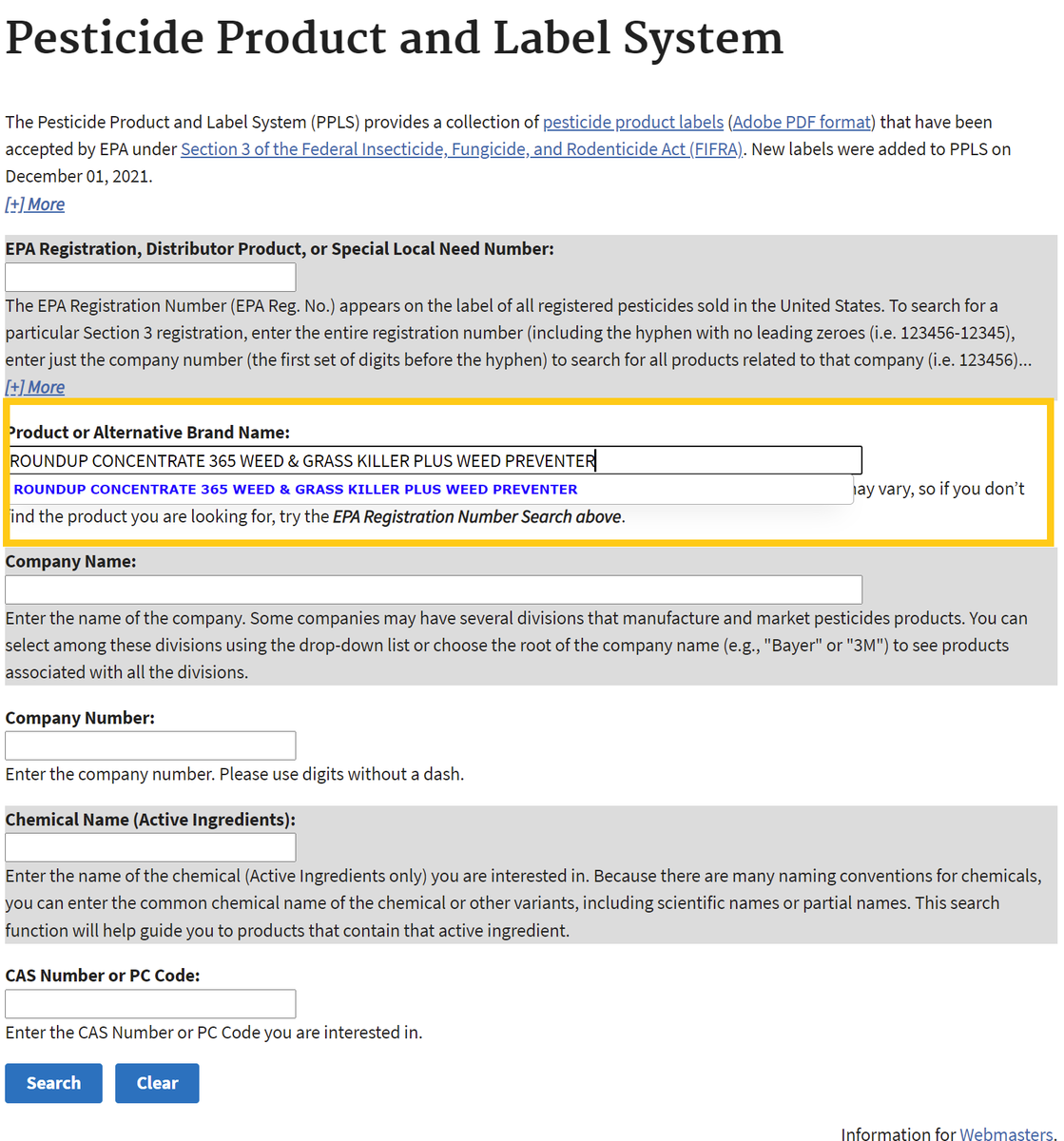
- After searching, click on the chemical ingredients tab or the link for the most recent label to find Active Ingredients.
Chemical List Label List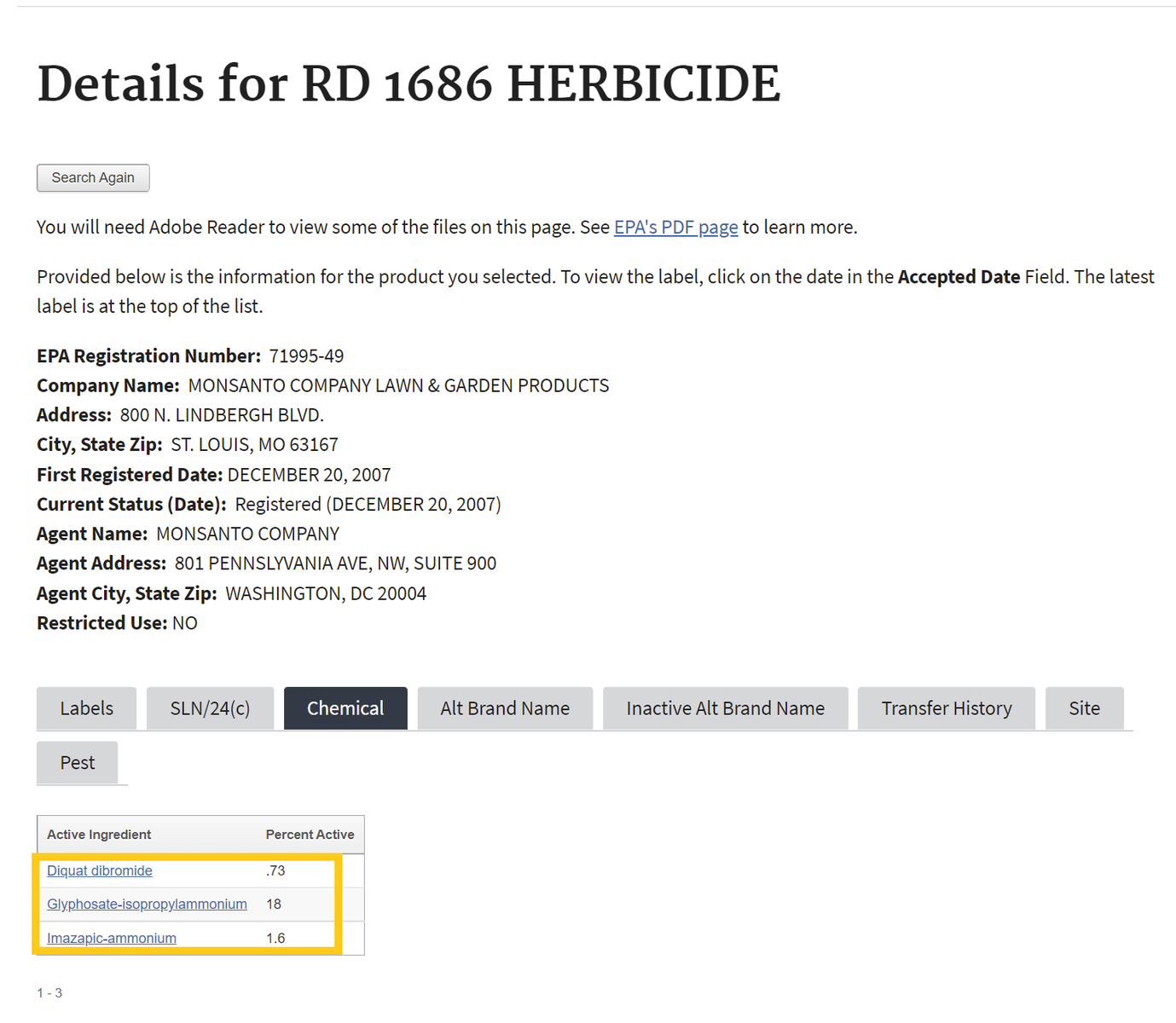
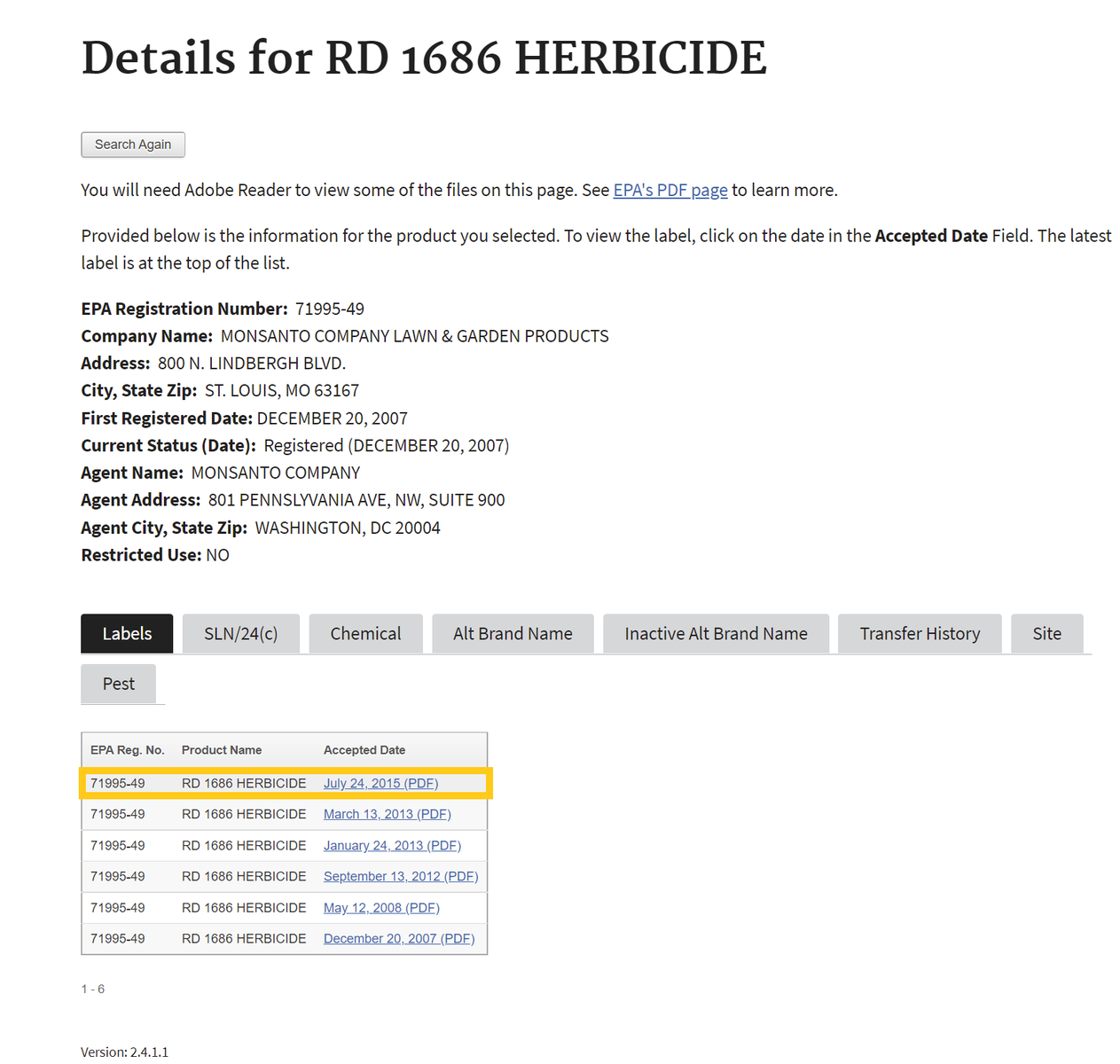
If one selects the chemical ingredients tab, skip to Step 4 . If not, proceed to step number 3 - To find the active ingredient(s) on the label, search for the page in the document containing the date of registration. Usually, the active ingredients section occurs within the first few pages of the label document.
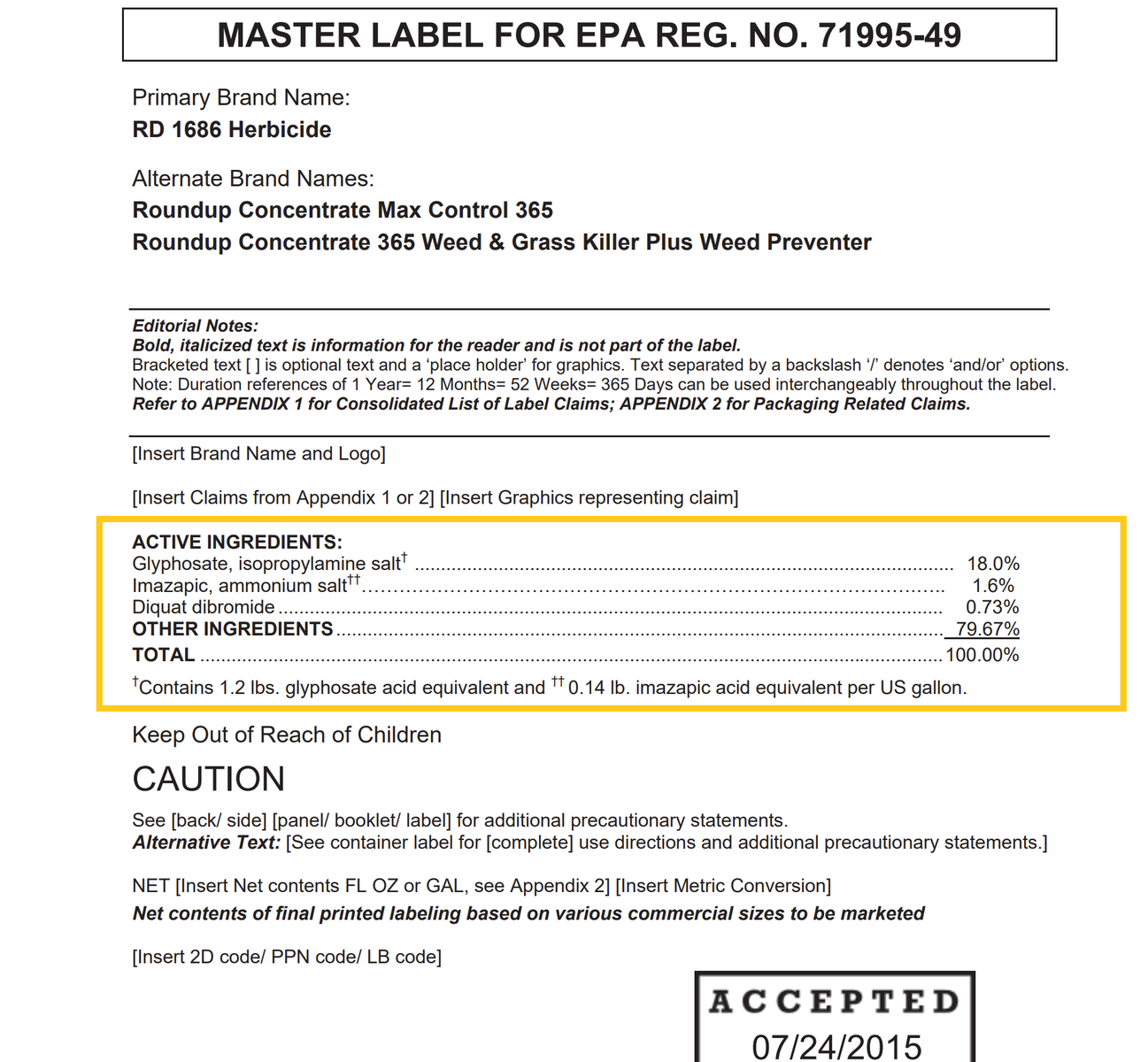
- Return to the Beyond Pesticides Gateway and search for the active ingredient name in the yellow box to the right or from the list below.
Clothianidin
General Information
- Product Names:
- Chemical Class: Nitroguanidine (subgroup of nicotinoids) insecticide
- Uses: Agriculture
- Alternatives: Organic Agriculture
- Beyond Pesticides rating: Toxic
Health and Environmental Effects
- Cancer: Not documented
- Endocrine Disruption: Not documented
- Reproductive Effects: Not documented
- Neurotoxicity: Yes (39)
- Kidney/Liver Damage: Not documented
- Sensitizer/ Irritant: Not documented
- Birth/Developmental: Not documented
- Detected in Groundwater: Not documented
- Potential Leacher: Not documented
- Toxic to Birds: Yes (79)
- Toxic to Fish/Aquatic Organisms: Yes (39)
- Toxic to Bees: Yes (39)
Residential Uses as Found in the ManageSafe™ Database
Additional Information
- Regulatory Status:
- Beyond Pesticides' Neonicotinoid Comments (October 2024)
- Clothianidin Registration Review
- EPA Actions on Pollinators
- Beyond Pesticides' Non-Pollinator Neonictinoid Assesment comments (4/2018)
- Beyond Pesticides' EPA registration review bee risk assessmnet comments (7/2017)
- Clothianidin EPA Petition and Response (2012)
- EPA Factsheet (2013)
- Supporting information:
- Daily News Blog
- Pesticides and Pollinators: Chemicals Implicated in Colony
- EFSA risk assessments of three neonicotinoids – clothianidin, imidacloprid and thiamethoxam
- EU Commission: Neonicotinoids
- EFSA consultation for thiamethoxam (2016)
- Poisoned Waterways (Beyond Pesticides, 2017)
- Net Loss—Economic Efficacy And Costs Of Neonicotinoid Insecticides Used As Seed Coatings: Updates From The United States And Europe (Center for Food Safety, 2016)
- Heavy Costs: Weighing the Value of Neonicotinoid Insecticides in Agriculture (Center for Food Safety, 2014)
- The Xerces Society - Neonicotinoids and Bees
- Studies:
- The neonicotinoid insecticide clothianidin adversely affects immune signaling in a human cell line. Di Prisco G, Iannaccone M, Ianniello F, et al. 2017. Sci Rep. 7(1):13446.
- Effects of neonicotinoid pesticide exposure on human health: a systematic review. Cimino AM, Boyles AL, Thayer KA, Perry MJ. 2017. Environ Health Perspect. 125:155–162
- Immunosuppression in Honeybee Queens by the Neonicotinoids Thiacloprid and Clothianidin. Brandt A, Grikscheit K, Siede R, et al. 2017. Sci Rep. 7(1):4673.
- Neonicotinoid clothianidin adversely affects insect immunity and promotes replication of a viral pathogen in honey bees. Di Prisco G, Cavaliere V, Annoscia D, et al. 2013. Proc Natl Acad Sci U S A. 110(46):18466-71
- First national-scale reconnaissance of neonicotinoid insecticides in streams across the U.S.A. Hladik, M.L. and Kolpin, D.W., 2016. Environ. Chem., v. 13, pp. 12-20.
- Pesticides are the dominant stressors for vulnerable insects in lowland streams. Liess, M., Liebmann, L., Vormeier, P., Weisner, O., Altenburger, R., Borchardt, D., Brack, W., Chatzinotas, A., Escher, B., Foit, K. and Gunold, R. Water Research, 201, p.117262.
- Neonicotinoid insecticides promote breast cancer progression via G protein-coupled estrogen receptor: In vivo, in vitro and in silico studies. Li, X., He, S., Xiao, H., He, T.T., Zhang, J.D., Luo, Z.R., Ma, J.Z., Yin, Y.L., Luo, L. and Cao, L.Y., 2022. Environment International, 170, p.107568.
- Neonicotinoids: Still present in farmland birds despite their ban. Fuentes, E., Gaffard, A., Rodrigues, A., Millet, M., Bretagnolle, V., Moreau, J. and Monceau, K., 2023. Chemosphere, 321, p.138091.
- Prevalence of neonicotinoid insecticides in paired private-well tap water and human urine samples in a region of intense agriculture overlying vulnerable aquifers in eastern Iowa. Thompson, D.A., Kolpin, D.W., Hladik, M.L., Lehmler, H.J., Meppelink, S.M., Poch, M.C., Vargo, J.D., Soupene, V.A., Irfan, N.M., Robinson, M. and Kannan, K., 2023. Chemosphere, 319, p.137904.
- Infantile Internal and External Exposure to Neonicotinoid Insecticides: A Comparison of Levels across Various Sources. Zhang, H., Wang, Y., Zhu, H., Lu, S., Wang, Y., Xue, J., Zhang, T., Kannan, K. and Sun, H., 2023. Environmental Science & Technology, 57(13), pp.5358-5367.
- Organic farming reduces pesticide load in a bird of prey. Fuentes, E. et al. (2024) Organic farming reduces pesticide load in a bird of prey, Science of The Total Environment. Available at: https://www.sciencedirect.com/science/article/pii/S0048969724029255.
- Comparing the effects of three neonicotinoids on embryogenesis of the South African clawed frog Xenopus laevis. Flach, H. et al. (2024) Comparing the effects of three neonicotinoids on embryogenesis of the South African clawed frog xenopus laevis, Current Research in Toxicology. Available at: https://www.sciencedirect.com/science/article/pii/S2666027X24000227?via%3Dihub.
- Immunosuppression in Honeybee Queens by the Neonicotinoids Thiacloprid and Clothianidin. Brandt, A. et al. (2017) Immunosuppression in honeybee queens by the neonicotinoids Thiacloprid and Clothianidin, Scientific Reports. Available at: https://pubmed.ncbi.nlm.nih.gov/28680118/.
- Neonicotinoid exposure increases Varroa destructor (Mesostigmata: Varroidae) mite parasitism severity in honey bee colonies and is not mitigated by increased colony genetic diversity. Bartlett, L.J. et al. (2024) Neonicotinoid exposure increases Varroa destructor (Mesostigmata: Varroidae) mite parasitism severity in honey bee colonies and is not mitigated by increased colony genetic diversity, Journal of Insect Science. Available at: https://academic.oup.com/jinsectscience/article/24/3/20/7683866.
- A single dose of clothianidin exposure induces varying sex-specific behavioral changes in adulthood depending on the developmental stage of its administration. Kaku, K. et al. (2024) A single dose of clothianidin exposure induces varying sex-specific behavioral changes in adulthood depending on the developmental stage of its administration, The Journal of Toxicological Sciences. Available at: https://www.jstage.jst.go.jp/article/jts/49/7/49_301/_article.
- Sex-specific behavioral effects of acute exposure to the neonicotinoid clothianidin in mice. Kubo, S. et al. (2022) Sex-specific behavioral effects of acute exposure to the neonicotinoid clothianidin in mice, Toxicology and Applied Pharmacology. Available at: https://www.sciencedirect.com/science/article/abs/pii/S0041008X22004288?via%3Dihub.
- Unveiling bee pollen's contamination with pesticides and mycotoxins: Current analytical procedures, results and regulation. Carrera, M. et al. (2024) Unveiling bee pollen’s contamination with pesticides and mycotoxins: Current analytical procedures, results and regulation, Trends in Analytical Chemistry. Available at: https://www.sciencedirect.com/science/article/abs/pii/S0165993624004187.
- Neonicotinoid pesticides: evidence of developmental neurotoxicity from regulatory rodent studies. Sass, J.B., Donley, N. and Freese, W. (2024) Neonicotinoid pesticides: evidence of developmental neurotoxicity from regulatory rodent studies, Frontiers in Toxicology. Available at: https://www.frontiersin.org/journals/toxicology/articles/10.3389/ftox.2024.1438890/full.
- Chronic neonicotinoid pesticide exposure and parasite stress differentially affects learning in honeybees and bumblebees. Piiroinen Saija and Goulson Dave 2016. Chronic neonicotinoid pesticide exposure and parasite stress differentially affects learning in honeybees and bumblebeesProc. R. Soc. B.28320160246 http://doi.org/10.1098/rspb.2016.0246
- The neonicotinoid clothianidin impairs memory processing in honey bees. Léa Tison, Alexander Rößner, Susan Gerschewski, Randolf Menzel, The neonicotinoid clothianidin impairs memory processing in honey bees, Ecotoxicology and Environmental Safety, Volume 180, 2019, Pages 139-145, ISSN 0147-6513, https://doi.org/10.1016/j.ecoenv.2019.05.007.
- Impact of Endocrine Disrupting Pesticide Use on Obesity: A Systematic Review. Pérez-Bermejo, M. et al. (2024) Impact of Endocrine Disrupting Pesticide Use on Obesity: A Systematic Review, Biomedicines. Available at: https://www.mdpi.com/2227-9059/12/12/2677.
- Widespread Use and Frequent Detection of Neonicotinoid Insecticides in Wetlands of Canada's Prairie Pothole Region. Main, A.R. et al. (2014) Widespread Use and Frequent Detection of Neonicotinoid Insecticides in Wetlands of Canada’s Prairie Pothole Region, PLOS ONE. Available at: https://journals.plos.org/plosone/article?id=10.1371%2Fjournal.pone.0092821.
- Residues and Bioavailability of Neonicotinoid Pesticide in Shaanxi Agricultural Soil. Hua, L., Zhao, D., Wang, H. et al. Residues and Bioavailability of Neonicotinoid Pesticide in Shaanxi Agricultural Soil. Water Air Soil Pollut 234, 129 (2023). https://doi.org/10.1007/s11270-023-06159-1
- Current-use pesticides in vegetation, topsoil and water reveal contaminated landscapes of the Upper Rhine Valley, Germany. Mauser, K.M., Wolfram, J., Spaak, J.W. et al. Current-use pesticides in vegetation, topsoil and water reveal contaminated landscapes of the Upper Rhine Valley, Germany. Commun Earth Environ 6, 166 (2025). https://doi.org/10.1038/s43247-025-02118-2
- Combined exposure to sublethal concentrations of an insecticide and a fungicide affect feeding, ovary development and longevity in a solitary bee. Sgolastra Fabio, Arnan Xavier, Cabbri Riccardo, Isani Gloria, Medrzycki Piotr, Teper Dariusz and Bosch Jordi 2018Combined exposure to sublethal concentrations of an insecticide and a fungicide affect feeding, ovary development and longevity in a solitary beeProc. R. Soc. B.28520180887 http://doi.org/10.1098/rspb.2018.0887
- Do novel insecticides pose a threat to beneficial insects?. Siviter Harry and Muth Felicity 2020 Do novel insecticides pose a threat to beneficial insects?Proc. R. Soc. B.28720201265 http://doi.org/10.1098/rspb.2020.1265
- Neonicotinoid insecticides can serve as inadvertent insect contraceptives. Straub Lars, Villamar-Bouza Laura, Bruckner Selina, Chantawannakul Panuwan, Gauthier Laurent, Khongphinitbunjong Kitiphong, Retschnig Gina, Troxler Aline, Vidondo Beatriz, Neumann Peter and Williams Geoffrey R. 2016 Neonicotinoid insecticides can serve as inadvertent insect contraceptives Proc. R. Soc. B.28320160506 http://doi.org/10.1098/rspb.2016.0506
- Sublethal neonicotinoid insecticide exposure reduces solitary bee reproductive success. Sandrock, C., Tanadini, L.G., Pettis, J.S., Biesmeijer, J.C., Potts, S.G. and Neumann, P. (2014), Sublethal neonicotinoid insecticide exposure reduces solitary bee reproductive success. Agr Forest Entomol, 16: 119-128. https://doi.org/10.1111/afe.12041
- Seed coating with a neonicotinoid insecticide negatively affects wild bees. Rundlöf, M., Andersson, G., Bommarco, R. et al. Seed coating with a neonicotinoid insecticide negatively affects wild bees. Nature 521, 77–80 (2015). https://doi.org/10.1038/nature14420
- Country-specific effects of neonicotinoid pesticides on honey bees and wild bees. Woodcock, B. A., Bullock, J. M., Shore, R. F., Heard, M. S., Pereira, M. G., Redhead, J., Ridding, L., Dean, H., Sleep, D., Henrys, P., Peyton, J., Hulmes, S., Hulmes, L., Sárospataki, M., Saure, C., Edwards, M., Genersch, E., Knäbe, S., & Pywell, R. F. (2017). Country-specific effects of neonicotinoid pesticides on honey bees and wild bees. Science (New York, N.Y.), 356(6345), 1393–1395. https://doi.org/10.1126/science.aaa1190
- Acute toxicity of 6 neonicotinoid insecticides to freshwater invertebrates. Raby, M., Nowierski, M., Perlov, D., Zhao, X., Hao, C., Poirier, D. G., & Sibley, P. K. (2018). Acute toxicity of 6 neonicotinoid insecticides to freshwater invertebrates. Environmental toxicology and chemistry, 37(5), 1430–1445. https://doi.org/10.1002/etc.4088
- Neonicotinoid mixture alters trophic interactions in a freshwater aquatic invertebrate community. Duchet, C., Hou, F., Sinclair, C. A., Tian, Z., Kraft, A., Kolar, V., Kolodziej, E. P., McIntyre, J. K., & Stark, J. D. (2023). Neonicotinoid mixture alters trophic interactions in a freshwater aquatic invertebrate community. The Science of the total environment, 897, 165419. https://doi.org/10.1016/j.scitotenv.2023.165419
- Acute toxicity of neonicotinoid insecticides to ground beetles (Coleoptera: Carabidae) from Pennsylvania. Pearsons, K. and Tooker, J. (2025) Acute toxicity of neonicotinoid insecticides to ground beetles (Coleoptera: Carabidae) from Pennsylvania, Environmental Entomology. Available at: https://academic.oup.com/ee/advance-article-abstract/doi/10.1093/ee/nvaf048/8128784.
- Toxicity of clothianidin to common Eastern North American fireflies. Pearsons KA, Lower SE, Tooker JF. 2021. Toxicity of clothianidin to common Eastern North American fireflies. PeerJ 9:e12495 https://doi.org/10.7717/peerj.12495
- Effect of Pesticides on Adult Rove Beetle Atheta coriaria (Coleoptera: Staphylinidae) Survival in Growing Medium. Raymond A. Cloyd, Nicholas R. Timmons, Jessica M. Goebel, Kenneth E. Kemp, Effect of Pesticides on Adult Rove Beetle Atheta coriaria (Coleoptera: Staphylinidae) Survival in Growing Medium, Journal of Economic Entomology, Volume 102, Issue 5, 1 October 2009, Pages 1750–1758, https://doi.org/10.1603/029.102.0504
- Toxic and Behavioral Effects to Carabidae of Seed Treatments Used on Cry3Bb1- and Cry1Ab/c-Protected Corn. Christopher A. Mullin, Michael C. Saunders, Timothy W. Leslie, David J. Biddinger, Shelby J. Fleischer, Toxic and Behavioral Effects to Carabidae of Seed Treatments Used on Cry3Bb1- and Cry1Ab/c-Protected Corn, Environmental Entomology, Volume 34, Issue 6, 1 December 2005, Pages 1626–1636, https://doi.org/10.1603/0046-225X-34.6.1626
- Inputs, source apportionment, and transboundary transport of pesticides and other polar organic contaminants along the lower Red River, Manitoba, Canada. Challis, J. K., Cuscito, L. D., Joudan, S., Luong, K. H., Knapp, C. W., Hanson, M. L., & Wong, C. S. (2018). Inputs, source apportionment, and transboundary transport of pesticides and other polar organic contaminants along the lower Red River, Manitoba, Canada. The Science of the total environment, 635, 803–816. https://doi.org/10.1016/j.scitotenv.2018.04.128
- Occurrence of Current-Use Pesticides in Paired Indoor Dust, Drinking Water, and Urine Samples from the United States: Risk Prioritization and Health Implications. Xie, Y., Li, J., Salamova, A., & Zheng, G. (2025). Occurrence of Current-Use Pesticides in Paired Indoor Dust, Drinking Water, and Urine Samples from the United States: Risk Prioritization and Health Implications. Environmental science & technology, 59(25), 12507–12519. https://doi.org/10.1021/acs.est.5c00961
- Non-target effects of clothianidin on monarch butterflies. Pecenka, J.R., Lundgren, J.G. Non-target effects of clothianidin on monarch butterflies. Sci Nat 102, 19 (2015). https://doi.org/10.1007/s00114-015-1270-y
- Milkweed in agricultural field margins - A neonicotinoid exposure route for pollinators at multiple life stages. Naujokaitis-Lewis, I., Endicott, S., Gaudreault, E., Maisonneuve, F., & Robinson, S. A. (2024). Milkweed in agricultural field margins - A neonicotinoid exposure route for pollinators at multiple life stages. The Science of the total environment, 951, 175622. https://doi.org/10.1016/j.scitotenv.2024.175622
- Quantifying Pesticide Exposure Risk for Monarch Caterpillars on Milkweeds Bordering Agricultural Land. Olaya-Arenas P and Kaplan I (2019) Quantifying Pesticide Exposure Risk for Monarch Caterpillars on Milkweeds Bordering Agricultural Land. Front. Ecol. Evol. 7:223. doi: 10.3389/fevo.2019.00223
- Urinary pesticide biomarkers from adolescence to young adulthood in an agricultural setting in Ecuador: Study of secondary exposure to pesticides among children, adolescents, and adults (ESPINA) 2016 and 2022 examination data. Parajuli, R. et al. (2025) Urinary pesticide biomarkers from adolescence to young adulthood in an agricultural setting in Ecuador: Study of secondary exposure to pesticides among children, adolescents, and adults (ESPINA) 2016 and 2022 examination data, Data in Brief. Available at: https://www.sciencedirect.com/science/article/pii/S2352340925006067.
- Exposure to multiple neonicotinoid insecticides, oxidative stress, and gestational diabetes mellitus: Association and potential mediation analyses. Mahai, Gaga et al. “Exposure to multiple neonicotinoid insecticides, oxidative stress, and gestational diabetes mellitus: Association and potential mediation analyses.” Environment international vol. 179 (2023): 108173. doi:10.1016/j.envint.2023.108173
- Pesticides residues and metabolites in honeybees: A Greek overview exploring Varroa and Nosema potential synergies. Kasiotis, Konstantinos M et al. “Pesticides residues and metabolites in honeybees: A Greek overview exploring Varroa and Nosema potential synergies.” The Science of the total environment vol. 769 (2021): 145213. doi:10.1016/j.scitotenv.2021.145213
- Neonicotinoid Clothianidin reduces honey bee immune response and contributes to Varroa mite proliferation. Annoscia, D., Di Prisco, G., Becchimanzi, A. et al. Neonicotinoid Clothianidin reduces honey bee immune response and contributes to Varroa mite proliferation. Nat Commun 11, 5887 (2020). https://doi.org/10.1038/s41467-020-19715-8
- Chronic oral lethal and sub-lethal toxicities of different binary mixtures of pesticides and contaminants in bees (Apis mellifera, Osmia bicornis and Bombus terrestris). Spurgeon, David & Hesketh, Helen & Lahive, Elma & Svendsen, Claus & Baas, Jan & Robinson, Alex & Horton, Alice & Heard, Matthew. (2016). Chronic oral lethal and sub‐lethal toxicities of different binary mixtures of pesticides and contaminants in bees (Apis mellifera, Osmia bicornis and Bombus terrestris). EFSA Supporting Publications. 13. 10.2903/sp.efsa.2016.EN-1076.
- Sub-lethal effects of six neonicotinoids on avoidance behavior and reproduction of earthworms (Eisenia fetida). Ge, Jing et al. “Sub-lethal effects of six neonicotinoids on avoidance behavior and reproduction of earthworms (Eisenia fetida).” Ecotoxicology and environmental safety vol. 162 (2018): 423-429. doi:10.1016/j.ecoenv.2018.06.064
- Pesticide Prioritization by Potential Biological Effects in Tributaries of the Laurentian Great Lakes. Oliver, S.K., Corsi, S.R., Baldwin, A.K., Nott, M.A., Ankley, G.T., Blackwell, B.R., Villeneuve, D.L., Hladik, M.L., Kolpin, D.W., Loken, L., DeCicco, L.A., Meyer, M.T. and Loftin, K.A. (2023), Pesticide Prioritization by Potential Biological Effects in Tributaries of the Laurentian Great Lakes. Environ Toxicol Chem, 42: 367-384. https://doi.org/10.1002/etc.5522








.png)
